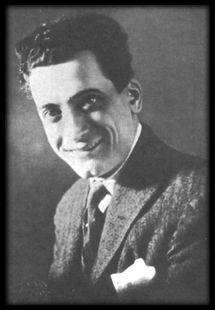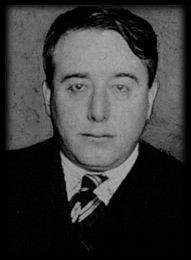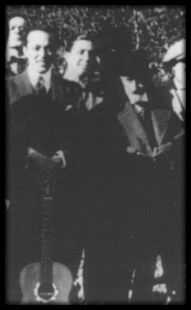By
Edmundo Guibourg and his memories with Gardel

.A.: In 1915 Gardel’s birthday has dramatic touches...
E.G.: «After the tour of Brazil, with the Guillermo Battaglia’s theater company, Gardel celebrated his birthday with his friends. It was December 11, 1915 and he was having his 25th birthday. In the evening they decided to go on a spree. They were four people: a scholar of the Buenos Aires lore whose family name was Abelenda and later became the administrator in the Muiño-Alippi company, the actor Carlos Morganti who was beginning as player of small theater parts, Elías Alippi who was already regarded as a prestigious lead actor, a rival for Francisco Ducasse and Gardel. And they went to the Palais de Glace. There, a quarrelsome drunkard picked on Alippi’s thinness and began to bother him, to challenge him eager to start a fight.
 «And who did step out to help Alippi? Gardel. Gardel who never was a bully accepted the challenge. But other partners of the drunkard appeared. Gardel had accepted because he thought they would not go further. They took a car to go to the Armenonville and when they were crossing Libertador and Agüero they were intercepted by the car driven by the bullies. They all got off to fight, a shot was heard and Gardel fell, wounded. The bullet pierced one of his lungs, with no exit hole. On no account would the surgeon operate him, so Gardel had to bear a bullet in his lung, but that was not an obstacle for his singing. But surely, that bullet brought trouble in the autopsy of his remains, giving rise to that lie about a fight in the plane that never existed. It’s a lie made up by Aguilar.
«And who did step out to help Alippi? Gardel. Gardel who never was a bully accepted the challenge. But other partners of the drunkard appeared. Gardel had accepted because he thought they would not go further. They took a car to go to the Armenonville and when they were crossing Libertador and Agüero they were intercepted by the car driven by the bullies. They all got off to fight, a shot was heard and Gardel fell, wounded. The bullet pierced one of his lungs, with no exit hole. On no account would the surgeon operate him, so Gardel had to bear a bullet in his lung, but that was not an obstacle for his singing. But surely, that bullet brought trouble in the autopsy of his remains, giving rise to that lie about a fight in the plane that never existed. It’s a lie made up by Aguilar.
C.A.: Here because of the bullet wound Gardel traveled to Uruguay, and that gave reason to those that now think that he was born in Tacuarembó, isn’t that so?
E.G.: «Yes, Gardel made a short trip to Tacuarembó in order to recover. There he met the caudillo Traverso’s youngest brother, Cielito Traverso, who had fled from Buenos Aires because he had murdered a rich guy at the Armenonville. Gardel met Cielito whom he had naturally come to know at the party committee. He spent his convalescence there —approximately a month— what explains that he may have got acquainted with people that could help him to get that forged identity card which says that he was born in Tacuarembó.»
C.A.: What did he want to get that document for? To get rid of the obligation to fight in the French ranks during the war that was taking place in Europe. Wasn’t it?
E.G.: «Sure, he had not fought in the First World War, he was a deserter. He wanted to become an Argentine citizen. The Uruguayan document is completely apocryphal.»
C.A.: This refutes the statements of the Uruguayan journalist Avlis, who asserts that Gardel was born in Uruguay...
E.G.: «Certainly. Avlis is a bona fide man. But he, like Tabaré and Matamoros, when were unable to explain and to establish their theories have turned to say that the true Gardel, the true son of Doña Berta died and was replaced by another child... Those are made-up stories, all novels full of lies and of purely sensationalist purposes.»
C.A.: To finish this chapter, can we say that in 1915 his permanent friendship with Gardel began?
 E.G.: «Yes, as from that period our very dear and close friendship began, all the way. Because of that our travel coincided in September or October 1927. I was assigned as correspondent for Crítica in Paris where I stayed for six years. Gardel traveled with me up to Spain, he came back to Buenos Aires, returned to Paris later and appeared to great acclaim. So we toured the whole world except North America and the interior of our country, because on those occasions I didn’t go with him. But I did accompany him as from Barcelona, Valladolid, Madrid, Seville... And later we met in Paris, in Rouen...
E.G.: «Yes, as from that period our very dear and close friendship began, all the way. Because of that our travel coincided in September or October 1927. I was assigned as correspondent for Crítica in Paris where I stayed for six years. Gardel traveled with me up to Spain, he came back to Buenos Aires, returned to Paris later and appeared to great acclaim. So we toured the whole world except North America and the interior of our country, because on those occasions I didn’t go with him. But I did accompany him as from Barcelona, Valladolid, Madrid, Seville... And later we met in Paris, in Rouen...
«Thereafter we went to London. We were in Rome, Hamburg. In sum, all Europe. A very hospitable, a very visitable Europe. We made beautiful trips, always trying to walk the cities to know them block by block... Then it seemed that he had invented what was later known as aerobics. They were drills that he had learnt in the Asociación Cristiana de Jóvenes (YMCA) where he practiced gymnastics and aerobics with an entrepreneur, husband of the actress Camila Quiroga. And on those hikes our dear comrade Juancito Caminador (Johnnie Walker) accompanied us (at this time of the conversation, Guibourg pointed out to a large caricature in a frame on a bookstand), the poet Raúl González Tuñón.»
C.A.: On those trips he might have visited Toulouse...
«Yes! He was there two or three times. One of them was to see his mother who had traveled to visit her relatives. He was in the house he was born and met his mother's relatives who, of course, might have asked him to sing.
«Now I'm going to tell you something he told me. I can't exactly say the date but he was already an adult. Surely he was around age 30. One day he told me:
—I'm going to tell you something that I've never told you. The old man was there...
—What old man?
—My father.
—Then, did you see him?
—No. He came from Toulouse to see my mother. He knew I am a known artist and he offered a late reparation. Mom told me... I asked her: «Mom, what did you answer him?» And she told me that it depended on what I would say to her. That all depended on my wish, not hers. «Do you need him, mom?» She told me she didn't need him.
—Me, either, not only I don't need him but also I don't want to see him".
—His name was Paul Lasserre. With two 's' and two 'r'. What I really want to tell you so that you will laugh a little with me is that... D'you know what my name is? Charles Romuald Lasserre.»
And it was fun for him. «Great!» —said he— «Great!»
C.A.: Didn't he know his true family name, his father's surname?
«No! Then he knew it. The man came from Toulouse, possibly to offer a reparation as a modest man. He was a middle class man, quite correct, it seems. A little bit rustic, a provincial man. Probably at the time he seduced Doña Berta he was married. And he maybe was a widower when he came. I don't know any more. I never made a research about that story. I recall that passing confidence, but I paid no attention to it and I ought to have.»
 C.A.: I'd like to finish this dialogue with some loose anecdote, just like the one you told me. For example, something that informs us about Gardel as tango researcher. Because there are people who say that he only sang and that was all. But to think that for him was the same to sing a tango or any other stuff, it seems to be at a dwarf's step. Did he have any theories about the subject?
C.A.: I'd like to finish this dialogue with some loose anecdote, just like the one you told me. For example, something that informs us about Gardel as tango researcher. Because there are people who say that he only sang and that was all. But to think that for him was the same to sing a tango or any other stuff, it seems to be at a dwarf's step. Did he have any theories about the subject?
«I'm going to answer as you wish. With an anecdote. Many times he used to explain things connected with tango. There is a famous case, when Don Jacinto Benavente invited us. He had just been awarded the Nobel prize. We found him in Paris, he invited us to lunch, to further talk about lyrics in tango. He wanted to know the roots of many lunfardo words. I remember that on that occasion Don Jacinto Benavente gave us a magisterial lesson about caló, calé (that are different Spanish jargons), the language of the gypsies... He gave us lessons on French argot, English slang...»
C.A.: All them equivalent to our lunfardo...
«Certainly. He knew everything. He even wanted to talk about the papiamento of the Caribbean Sea, the language used by pirates and smugglers. He himself explained to us the origins of gayola, guita, chamuyo, fariñera, bondi. But there were some tangos he was unable to decipher completely. For example, it was hard for him to understand that «mosaico diquero» mentioned in “El ciruja” was a challenging tasty girl. It was a conversation that might have lasted three hours. Finally, after too much talking, when we stood up to leave the table, Gardel told me: «I had thought I was a singer but now it turns out I'm a philologist. Do you understand?» And with that subject he went on for several days, searching the works of the Spanish Golden Century —Lope de Vega, Lope de Rueda, Cervantes— for the references made by Don Jacinto Benavente.»
Published in the Flash magazine, 1985.